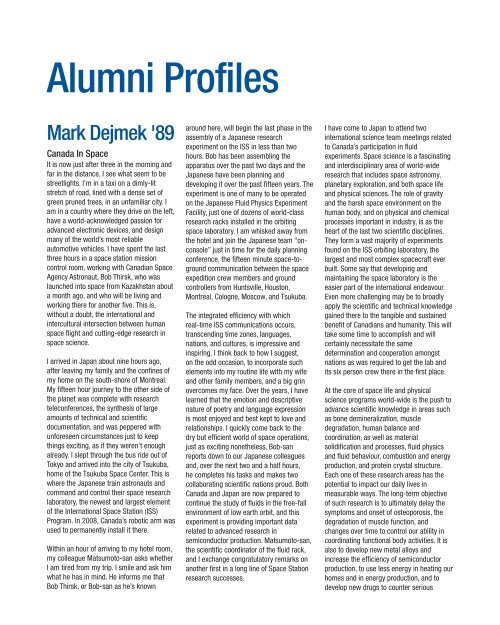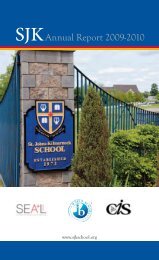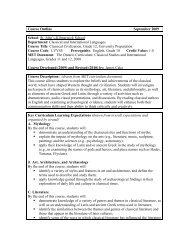2008 - 2009 Annual Report - St. John's-Kilmarnock School
2008 - 2009 Annual Report - St. John's-Kilmarnock School
2008 - 2009 Annual Report - St. John's-Kilmarnock School
You also want an ePaper? Increase the reach of your titles
YUMPU automatically turns print PDFs into web optimized ePapers that Google loves.
Alumni Profiles<br />
Mark Dejmek '89<br />
Canada In Space<br />
It is now just after three in the morning and<br />
far in the distance, I see what seem to be<br />
streetlights. I’m in a taxi on a dimly-lit<br />
stretch of road, lined with a dense set of<br />
green pruned trees, in an unfamiliar city. I<br />
am in a country where they drive on the left,<br />
have a world-acknowledged passion for<br />
advanced electronic devices, and design<br />
many of the world’s most reliable<br />
automotive vehicles. I have spent the last<br />
three hours in a space station mission<br />
control room, working with Canadian Space<br />
Agency Astronaut, Bob Thirsk, who was<br />
launched into space from Kazakhstan about<br />
a month ago, and who will be living and<br />
working there for another five. This is,<br />
without a doubt, the international and<br />
intercultural intersection between human<br />
space flight and cutting-edge research in<br />
space science.<br />
I arrived in Japan about nine hours ago,<br />
after leaving my family and the confines of<br />
my home on the south-shore of Montreal.<br />
My fifteen hour journey to the other side of<br />
the planet was complete with research<br />
teleconferences, the synthesis of large<br />
amounts of technical and scientific<br />
documentation, and was peppered with<br />
unforeseen circumstances just to keep<br />
things exciting, as if they weren’t enough<br />
already. I slept through the bus ride out of<br />
Tokyo and arrived into the city of Tsukuba,<br />
home of the Tsukuba Space Center. This is<br />
where the Japanese train astronauts and<br />
command and control their space research<br />
laboratory, the newest and largest element<br />
of the International Space <strong>St</strong>ation (ISS)<br />
Program. In <strong>2008</strong>, Canada’s robotic arm was<br />
used to permanently install it there.<br />
Within an hour of arriving to my hotel room,<br />
my colleague Matsumoto-san asks whether<br />
I am tired from my trip. I smile and ask him<br />
what he has in mind. He informs me that<br />
Bob Thirsk, or Bob-san as he’s known<br />
around here, will begin the last phase in the<br />
assembly of a Japanese research<br />
experiment on the ISS in less than two<br />
hours. Bob has been assembling the<br />
apparatus over the past two days and the<br />
Japanese have been planning and<br />
developing it over the past fifteen years. The<br />
experiment is one of many to be operated<br />
on the Japanese Fluid Physics Experiment<br />
Facility, just one of dozens of world-class<br />
research racks installed in the orbiting<br />
space laboratory. I am whisked away from<br />
the hotel and join the Japanese team “onconsole”<br />
just in time for the daily planning<br />
conference, the fifteen minute space-toground<br />
communication between the space<br />
expedition crew members and ground<br />
controllers from Huntsville, Houston,<br />
Montreal, Cologne, Moscow, and Tsukuba.<br />
The integrated efficiency with which<br />
real-time ISS communications occurs,<br />
transcending time zones, languages,<br />
nations, and cultures, is impressive and<br />
inspiring. I think back to how I suggest,<br />
on the odd occasion, to incorporate such<br />
elements into my routine life with my wife<br />
and other family members, and a big grin<br />
overcomes my face. Over the years, I have<br />
learned that the emotion and descriptive<br />
nature of poetry and language expression<br />
is most enjoyed and best kept to love and<br />
relationships. I quickly come back to the<br />
dry but efficient world of space operations,<br />
just as exciting nonetheless. Bob-san<br />
reports down to our Japanese colleagues<br />
and, over the next two and a half hours,<br />
he completes his tasks and makes two<br />
collaborating scientific nations proud. Both<br />
Canada and Japan are now prepared to<br />
continue the study of fluids in the free-fall<br />
environment of low earth orbit, and this<br />
experiment is providing important data<br />
related to advanced research in<br />
semiconductor production. Matsumoto-san,<br />
the scientific coordinator of the fluid rack,<br />
and I exchange congratulatory remarks on<br />
another first in a long line of Space <strong>St</strong>ation<br />
research successes.<br />
I have come to Japan to attend two<br />
international science team meetings related<br />
to Canada’s participation in fluid<br />
experiments. Space science is a fascinating<br />
and interdisciplinary area of world-wide<br />
research that includes space astronomy,<br />
planetary exploration, and both space life<br />
and physical sciences. The role of gravity<br />
and the harsh space environment on the<br />
human body, and on physical and chemical<br />
processes important in industry, is as the<br />
heart of the last two scientific disciplines.<br />
They form a vast majority of experiments<br />
found on the ISS orbiting laboratory, the<br />
largest and most complex spacecraft ever<br />
built. Some say that developing and<br />
maintaining the space laboratory is the<br />
easier part of the international endeavour.<br />
Even more challenging may be to broadly<br />
apply the scientific and technical knowledge<br />
gained there to the tangible and sustained<br />
benefit of Canadians and humanity. This will<br />
take some time to accomplish and will<br />
certainly necessitate the same<br />
determination and cooperation amongst<br />
nations as was required to get the lab and<br />
its six person crew there in the first place.<br />
At the core of space life and physical<br />
science programs world-wide is the push to<br />
advance scientific knowledge in areas such<br />
as bone demineralization, muscle<br />
degradation, human balance and<br />
coordination, as well as material<br />
solidification and processes, fluid physics<br />
and fluid behaviour, combustion and energy<br />
production, and protein crystal structure.<br />
Each one of these research areas has the<br />
potential to impact our daily lives in<br />
measurable ways. The long-term objective<br />
of such research is to ultimately delay the<br />
symptoms and onset of osteoporosis, the<br />
degradation of muscle function, and<br />
changes over time to control our ability in<br />
coordinating functional body activities. It is<br />
also to develop new metal alloys and<br />
increase the efficiency of semiconductor<br />
production, to use less energy in heating our<br />
homes and in energy production, and to<br />
develop new drugs to counter serious





